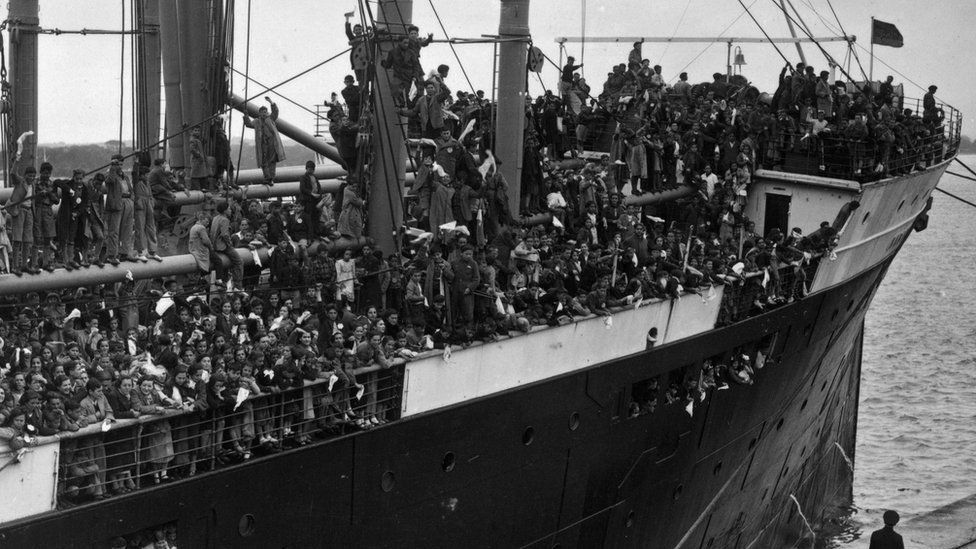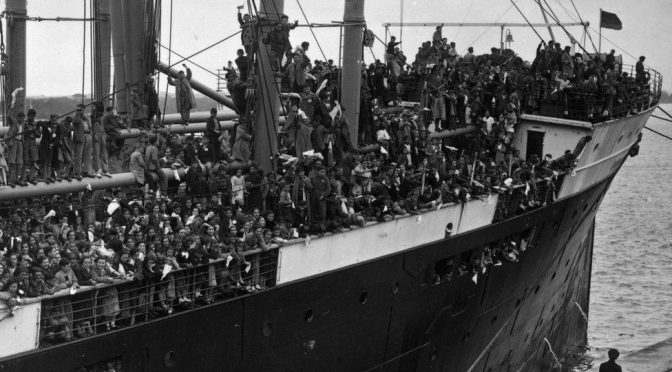During the Spanish Civil War, particularly the years of 1936-1937, thousands of women and children, many of the latter without their parents, were evacuated from the Basque Country to a variety of countries, including the Soviet Union, France, Belgium, Switzerland, and Denmark. I’ll write about some of these others in the future. However, a key destination for many of these children was the United Kingdom.

- On May 21, 1937, the ship SS Habana left the Basque port of Santurce with some 4,000 children, headed for the British city of Southampton. They stayed in the Stoneham camp, consisting of some 250 tents, organized by the Basque Children’s Committee. The evacuation to Britain was not without controversy, as some in the British government viewed it as a breach of the non-interventionist policy and others argued it would prolong the war by reducing the number of “mouths… that don’t have to be fed” by the Basque government.
- The children were placed all across the country in what were called colonies. For example, about 60 children were placed at Beach House, in Worthing. The government provided no support – rather, the hosting families and other volunteers raised the necessary funds and clothing to support the children. In fact, the government demanded that the Basque Children’s Committee guarantee 10 shillings per week per child to pay for the care and education. The children stayed there for a few years before most returned to the Basque Country. A plaque was recently placed on the Beach House by the Basque Children of ’37 Association to commemorate their role in aiding these children.
- While most children eventually returned home to the Basque Country – by 1940 only about 500 remained in the UK – others made new lives in their adopted countries. Sabino Barinaga and Raimundo Perez Lezama, two of the 4,000 children to arrive in 1937, became professional soccer players. 14 years old when they arrived in the UK, they honed their soccer skills on British fields before returning to Spain. Barinaga played for Real Madrid while Lezama was a goalkeeper for Athletic Bilbao. They met in the 1943 Spanish Cup final where Lezama’s Athletic Bilbao team beat Real Madrid 1-0. Other refugee children also made careers in soccer following their encampment in the UK.
- Another 230 children were sent to Wales. The Basque Country and Wales have a long history of interchange, with Basques working in Welsh industrial cities in the 1880s and Welsh workers doing the same in the early 1900s. 56 of these children made it to Caerleon and soccer was again a distraction from the harsh realities of being so far from home in the middle of a war. They formed a team, called by some “The Basque Wonder Team” and “The Basque Unbeatables,” that became somewhat of a sensation in southern Wales. One of the boys, Enrique Garatea Bello, became a professional goalie back in Spain after returning home.
Primary sources: Arrien Berrojaechevarría, Gregorio. NIÑO, NIÑA (NIÑOS EN LA GUERRA). Auñamendi Encyclopedia, 2022. Available at: https://aunamendi.eusko-ikaskuntza.eus/en/nino-nina-ninos-en-la-guerra/ar-79019/
Discover more from Buber's Basque Page
Subscribe to get the latest posts sent to your email.



My mother-in-law, now living in Zarautz, was one of the children. She arrived in Southampton aged 9, with her older sister and younger brother. The sister stayed in the UK and married, the brother eventually became a ballet dancer in London, and my mother-in-law returned to the Basque Country aged 19, after the 2nd world war was over. She only has good things to say about the experiences in Kent.
Now my wife and I are able to repay the debt by taking in refugees ourselves, from Ukraine.
Thanks for the story, Andrew! Did your mother-in-law’s brother and sister maintain any ties to the Basque Country or did they completely assimilate into the local culture? I can’t imagine having to move to another country with a completely different language at such a young age, but here the world is, doing it again. It is bittersweet that you now have the opportunity to repay that debt.
It’s probably much easier to learn a new language as a youngster completely immersed in the culture, than to learn Euskara as a retiree, which is what I did.
The worst thing for the trio was being separated from their parents (who during the war escaped to Mexico) at such a young age.
After the war the older sister stayed in the UK, married a Spaniard, and they integrated totally into London life.
The brother, who danced with Saddlers Wells Company & The Royal Ballet, eventually moved to Portugal to teach ballet and then spent his last years in Zarautz.
My mother-in-law used the language she’d learnt in Kent and became a teacher of English in Guipuzkoa. She still reads novels in English, not in Basque or Spanish
For all of them family and Basque identity were very important.
I have a novel under consideration for publication part of which follows the journey of a refugee basque boy. the research was humbling as well as fascinating.